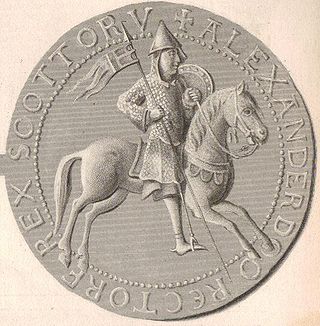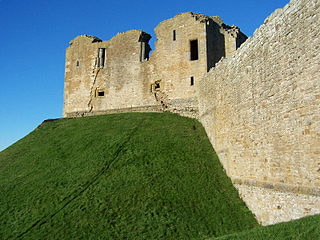Related Research Articles

Alexander I, posthumously nicknamed The Fierce, was the King of Scotland from 1107 to his death. He succeeded his brother, King Edgar, and his successor was his brother David. He was married to Sybilla of Normandy, an illegitimate daughter of Henry I of England.
Guillaume or William de Malveisin was Chancellor of Scotland, Bishop of Glasgow (1199/1200–1202) and then Bishop of St. Andrews (1202–1238).
John Scotus was a 12th-century bishop of St. Andrews and Dunkeld.
Hugh the Chaplain was the royal Chaplain of King William I of Scotland before becoming Bishop of Cell Rígmonaid (St Andrews), the highest ranking Scottish see of the period. After the death of Bishop Richard, King William selected Hugh to succeed to the bishopric in 1178. However, unbeknown to the king, the chapter elected their archdeacon, John l'Escot, as bishop. The king saw to Hugh's election and consecration in the same year. There followed a five-year struggle for the bishopric. John travelled to appeal to Pope Alexander III, who quashed the case of Hugh and sent to Scotland a man named Alexius as legate. Alexius obtained entrance to William's kingdom, and consecrated John at Holyrood Abbey in the presence of four other Scottish bishops, in the year 1180. Nevertheless, the struggle continued, and in 1183, both John and Hugh resigned their rights. Despite the fact that Hugh received the bishopric and John took the Bishopric of Dunkeld in compensation, dispute over revenues continued. When Hugh refused to answer his summons to Rome in 1186, he was suspended and excommunicated, with the diocese being put under interdict. Hugh travelled to Rome and obtained absolution, but he died of the pestilence in that city a few days later.
Adam of Melrose was Abbot of Melrose and Bishop of Caithness, famously burned to death by the husbandmen of Caithness. At the time, Caithness was part of the Jarldom of Orkney, which formed part of the Kingdom of Norway.

Bricius was prior of Lesmahagow and afterward bishop of Moray.
Andreas de Moravia was a 13th-century Scottish bishop. He was a younger son of Hugh de Moravia, from the family of Flemish origin who were lords of Duffus and other areas in the Greater Moray region in this period. In the time of Bishop Bricius' episcopate (1203–1222), there was a man called "Andreas" who was rector of the church of St. Peter at Duffus, and this may well have been this Andreas. He may also have been a native Scot.
Jocelin was a twelfth-century Cistercian monk and cleric who became the fourth Abbot of Melrose before becoming Bishop of Glasgow, Scotland. He was probably born in the 1130s, and in his teenage years became a monk of Melrose Abbey. He rose in the service of Abbot Waltheof, and by the time of the short abbacy of Waltheof's successor Abbot William, Jocelin had become prior. Then in 1170 Jocelin himself became abbot, a position he held for four years. Jocelin was responsible for promoting the cult of the emerging Saint Waltheof, and in this had the support of Enguerrand, Bishop of Glasgow.
William de Bondington was a 13th-century Chancellor of Scotland and a bishop of Glasgow.
John was an early 12th-century Tironensian cleric. He was the chaplain and close confidant of King David I of Scotland, before becoming Bishop of Glasgow and founder of Glasgow Cathedral. He was one of the most significant religious reformers in the history of Scotland. His later nickname, "Achaius", a latinisation of Eochaid would indicate that he was Gaelic, but the name is probably not authentic. He was in fact a Tironensian monk, of probable French origin.

Freskin was a Flemish nobleman who settled in Scotland during the reign of King David I, becoming the progenitor of the Murray and Sutherland families, and possibly others.
Alan de St Edmund was a 13th-century English cleric and administrator of the Roman Catholic Church. His name suggests a connection with Bury St. Edmunds Abbey in Suffolk, but there is no direct evidence. He was the chaplain of Hugh of Evesham, another Englishman, from the diocese of Worcester, who in 1282 was made Presbyter-Cardinal of St Laurence in Lucina by Pope Martin IV. After Hervey de Dundee, bishop-elect of Caithness, died while seeking confirmation at the Roman curia, the pope chose Alan - still in Rome - for the bishopric. Alan was provided by Pope Martin on 13 April 1282.
The Diocese of Moray was one of the most important of the medieval dioceses of the Roman Catholic Church in Scotland. Its territory was in central northern Scotland.
Robert Lauder was a Scottish prelate and Nuncio of the 15th century. The Lauder family produced a large number of senior churchman in this period, and alongside Robert can be named William Lauder, Bishop of Glasgow, Alexander Lauder and Thomas Lauder, both Bishop of Dunkeld, and George Lauder, Bishop of Argyll.
Alexander Bur was a 14th-century Scottish cleric. It is highly possible that Bur came from somewhere in or around Aberdeenshire, although that is not certain and is only based on the knowledge that Aberdeenshire is where other people bearing his surname come from in this period. He entered the service of King David II of Scotland sometime after 1343, perhaps as a member of David's exiled court at Château Gaillard. Although Alexander by this point in time already held prebends in both the bishopric of Aberdeen and the bishopric of Dunkeld, on that date King David petitioned Pope Clement VI for another canonry in the bishopric of Moray. Alexander had become a royal clerk and had obtained a Licentiate in Canon Law by 1350. By the latter date, upon the death of Adam Penny, Archdeacon of Moray, Alexander himself became Archdeacon.
Robert Capellanus, was a chaplain of King William I of Scotland and afterwards, Bishop of Ross (1214–1249).
Robert de Fyvie [also de Fyvin] was a prelate based in the Kingdom of Scotland in the last quarter of the 13th century. Perhaps coming from Fyvie in Formartine, from a family of Teesdale origin, Robert was Archdeacon of Ross and a student at the University of Bologna by 1269. In 1275, he was not only a graduate but the new Bishop of Ross, a post he held until his death in the first half of the 1290s.
Capellanus (chaplain) may refer to 12/13th century figures:
Walter Stewart was a 15th-century churchman in the Kingdom of Scotland. He was a cousin of King James II of Scotland, being like King James a grandson to King Robert III of Scotland.

Cum universi is a papal bull written by Pope Celestine III, issued on 13 March 1192. The bull ended the claim of the Archbishop of York to metropolitan jurisdiction in Scotland and established an independent national church, albeit one with no figurehead.
References
- Dowden, John, The Bishops of Scotland, ed. J. Maitland Thomson, (Glasgow, 1912)